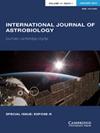Searching for biosignatures by their rotational spectrum: global fit and methyl group internal rotation features of dimethylsulphoxide up to 116 GHz
IF 1
4区 物理与天体物理
Q3 ASTRONOMY & ASTROPHYSICS
引用次数: 1
Abstract
Abstract The identification and quantification of molecules in interstellar space and atmospheres of planets in the solar systems and in exoplanets rely on spectroscopic methods and laboratory work is essential to provide the community with the spectral features needed to analyse cosmological observations. Rotational spectroscopy in particular, with its intrinsic high resolution, allows the unambiguous identification of biomolecular building blocks and biosignature gases which can be correlated with the origin of life or the identification of habitable planets. We report the extension of the measured rotational transition frequencies of dimethylsulphoxide and its 34S and 13C isotopologues in the millimetre wave range (59.6–78.4 GHz) by use of an absorption spectrometer based on the supersonic expansion technique. Hyperfine patterns related to the methyl group internal rotation were analysed in the microwave range region (6–18 GHz) with a Pulsed Jet Fourier Transform spectrometer at extremely high resolution (2 kHz) and reliable predictions up to 116 GHz are provided. The focus on sulphur-bearing molecules is motivated by the fact that sulphur is largely involved in the intra- and inter-molecular hydrogen bonds in proteins and although it is the 10th most abundant element in the known Universe, understanding its chemistry is still a matter of debate. Moreover, sulphur-bearing molecules, in particular dimethylsulphoxide, have been indicated as possible biosignature gases to be monitored in the search of habitable exoplanets.通过旋转光谱寻找生物特征:二甲基亚砜在116GHz下的全局拟合和甲基内旋转特征
摘要太阳系和系外行星的星际空间和大气层中分子的识别和量化依赖于光谱方法和实验室工作,对于为社区提供分析宇宙学观测所需的光谱特征至关重要。特别是旋转光谱,凭借其固有的高分辨率,可以明确识别生物分子构建块和生物信号气体,这些物质可以与生命起源或宜居行星的识别相关联。我们报道了通过使用基于超声膨胀技术的吸收光谱仪,在毫米波范围(59.6–78.4 GHz)内测量的二甲基亚砜及其34S和13C同位素的旋转跃迁频率的扩展。在微波范围(6–18 GHz)内,用脉冲射流傅立叶变换光谱仪以极高的分辨率(2 kHz)分析了与甲基内旋相关的超精细模式,并提供了高达116 GHz的可靠预测。硫在很大程度上参与了蛋白质的分子内和分子间氢键,尽管硫是已知宇宙中含量第十丰富的元素,但对其化学性质的理解仍然存在争议。此外,含硫分子,特别是二甲基亚砜,已被认为是寻找宜居系外行星时可能监测的生物信号气体。
本文章由计算机程序翻译,如有差异,请以英文原文为准。
求助全文
约1分钟内获得全文
求助全文
来源期刊

International Journal of Astrobiology
地学天文-地球科学综合
CiteScore
3.70
自引率
11.80%
发文量
45
审稿时长
>12 weeks
期刊介绍:
International Journal of Astrobiology is the peer-reviewed forum for practitioners in this exciting interdisciplinary field. Coverage includes cosmic prebiotic chemistry, planetary evolution, the search for planetary systems and habitable zones, extremophile biology and experimental simulation of extraterrestrial environments, Mars as an abode of life, life detection in our solar system and beyond, the search for extraterrestrial intelligence, the history of the science of astrobiology, as well as societal and educational aspects of astrobiology. Occasionally an issue of the journal is devoted to the keynote plenary research papers from an international meeting. A notable feature of the journal is the global distribution of its authors.
 求助内容:
求助内容: 应助结果提醒方式:
应助结果提醒方式:


